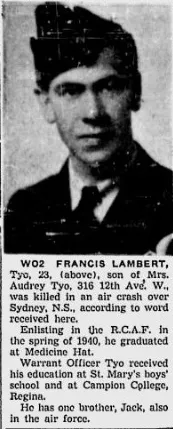Duncan, Robert Bryson (Flight Lieutenant)
Killed in Action 1943-October-03

Birth Date: 1914-November-28
Born:
Parents: Son of Dr. James William Duncan and Belle A. Duncan, of Montreal; husband of Kathleen M. Duncan, of Westmount.
Spouse: Husband of Kathleen M. Duncan, of Westmount.
Home: Montreal, Quebec
Enlistment:
Enlistment Date: unkown date
Service
RCAF
Unit
113 (BR) Sqn- Squadron
Base
RCAF Stn. Sydney, NS
Rank
Flight Lieutenant
Position
Service Numbers
C/13380
Home
Crew or Other Personnel
Ventura 2148
Ventura serial: 2148

A Lockheed PV-1 Ventura
The Lockheed Ventura is a twin-engine medium bomber and patrol bomber of World War II.
The Ventura first entered combat in Europe as a bomber with the RAF in late 1942. Designated PV-1 by the United States Navy (US Navy), it entered combat in 1943 in the Pacific. The bomber was also used by the United States Army Air Forces (USAAF), which designated it the Lockheed B-34 (Lexington) and B-37 as a trainer. British Commonwealth forces also used it in several guises, including antishipping and antisubmarine search and attack.
The Ventura was developed from the Lockheed Model 18 Lodestar transport, as a replacement for the Lockheed Hudson bombers then in service with the Royal Air Force. Used in daylight attacks against occupied Europe, they proved to have weaknesses and were removed from bomber duty and some used for patrols by Coastal Command.
At the start of the war, Lockheed proposed military conversions of the Lodestar for the RAF as replacement for the Hudson reconnaissance aircraft and the Bristol Blenheim bomber. The first British order was placed in February 1940 for 25 Model 32 as bombers. This was followed by an order for 300 Model 37 with Double Wasp engines, then for a further 375 later in 1940. Lockheed needed more production capacity and nearby Vega Aircraft Corporation was contracted for building the Ventura.
The Ventura was very similar to its predecessor, the Lockheed Hudson. The primary difference was not in layout; rather, the Ventura was larger, heavier, and used more powerful engines than the Hudson. The RAF ordered 188 Venturas in February 1940, which were delivered from mid-1942. Venturas were initially used for daylight raids on occupied Europe but, like some other RAF bombers, they proved too vulnerable without fighter escort, which was difficult to provide for long-range missions. Venturas were replaced by the faster de Havilland Mosquito. The Venturas were transferred to patrol duties with Coastal Command as the Mosquito replaced them in bomber squadrons; 30 went to the Royal Canadian Air Force (RCAF) and some to the South African Air Force (SAAF). The RAF placed an order for 487 Ventura Mark IIs but many of these were diverted to the USAAF, which placed its own order for 200 Ventura Mark IIA as the B-34 Lexington, later renamed RB-34.
A total of 157 Ventura G.R. Mk. Vs were used operationally by the RCAF from 16 June 1942 to 18 April 1947 in the home defence coastal patrol role in both Eastern and Western Air Command. They were flown by 8, 113, 115, 145, and 149 Squadrons. A further 21 Ventura Mk. Is and 108 Ventura Mk. IIs were used in a training role at 1 Central Flying School, Trenton, Ontario, and at RCAF Station Pennfield Ridge, New Brunswick (RAF No. 34 Operational Training Unit) as part of the BCATP. A total of 21 Mk. Is, 108 Mk. IIs, and 157 G.R. Mk. Vs were in service during this period for a total of 286 aircraft. Wikipedia
Aircraft Images
Ventura 2148
Ventura G.R. Mk. V 2148
Ex-USN, BuNo. 33087. Assigned to No. 113 Sqn. Struck off after Cat "A" crash on 03 Oct 1943. At18:39 hrs on 03 oct 1943, the a/c took off from Sidney, NS on a cross country flight ferrying
passengers to Dartmouth, NS. The a/c made a circuit of the aerodrome at very low altitude (50 ft or
less) and then commenced a 2nd circuit. In the 2nd attempt, the a/c pulled up into a steep vertical bank to port, stalled and then crashed to the ground from 250 ft. The cause of the accident was attributed to pilot error in maneuvering a heavily loaded a/c too low and too aggressively. All six onboard the a/c perished. These included: W/C A. Laut (2nd pilot), Flying Officer G.D. Issacs (pilot), Warrant Officer Class 2 F.L. Tye (Nav), Warrant Officer Class 2 W.R. Drake (WAG), Flight Sergeant G.P. O'Donnel (WAG) and Flight Lieutenant .B. Ducan (passenger).
1943-04-19 Taken on Strength 2019-08-20
1943-October-03 Accident: 113 Squadron Loc: Sydney Names: Drake | Duncan | Isaacs | Laut | O'Donnell | Tyo
1944-01-17 Struck off Strength Struck off after Category A crash, date unknown. 2019-08-20





